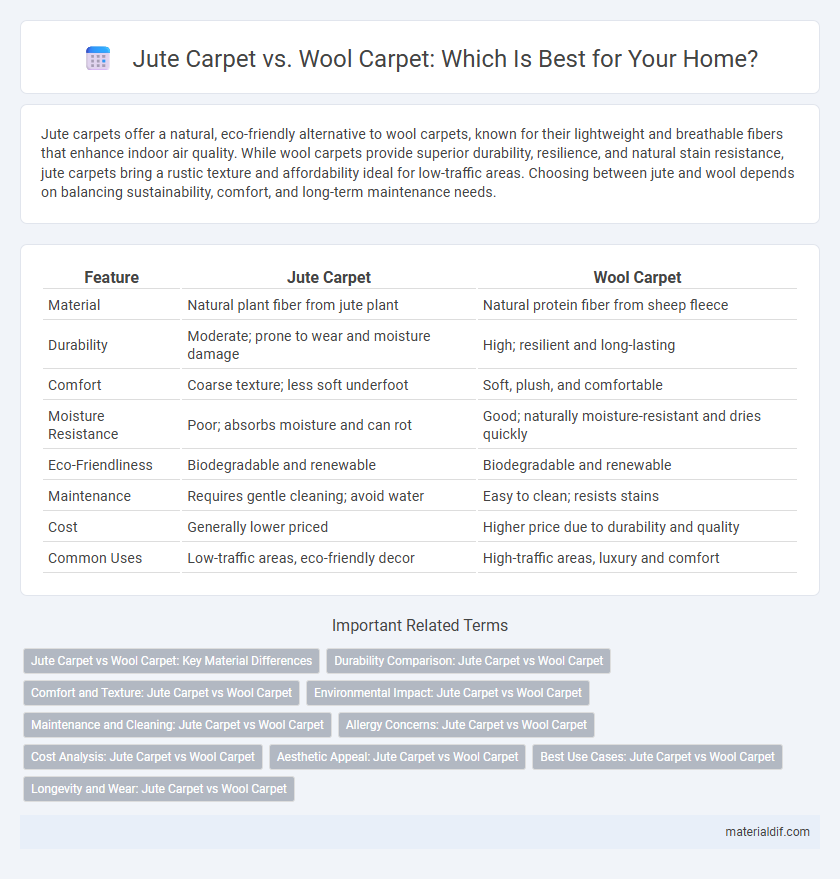Jute carpets offer a natural, eco-friendly alternative to wool carpets, known for their lightweight and breathable fibers that enhance indoor air quality. While wool carpets provide superior durability, resilience, and natural stain resistance, jute carpets bring a rustic texture and affordability ideal for low-traffic areas. Choosing between jute and wool depends on balancing sustainability, comfort, and long-term maintenance needs.
Table of Comparison
| Feature | Jute Carpet | Wool Carpet |
|---|---|---|
| Material | Natural plant fiber from jute plant | Natural protein fiber from sheep fleece |
| Durability | Moderate; prone to wear and moisture damage | High; resilient and long-lasting |
| Comfort | Coarse texture; less soft underfoot | Soft, plush, and comfortable |
| Moisture Resistance | Poor; absorbs moisture and can rot | Good; naturally moisture-resistant and dries quickly |
| Eco-Friendliness | Biodegradable and renewable | Biodegradable and renewable |
| Maintenance | Requires gentle cleaning; avoid water | Easy to clean; resists stains |
| Cost | Generally lower priced | Higher price due to durability and quality |
| Common Uses | Low-traffic areas, eco-friendly decor | High-traffic areas, luxury and comfort |
Jute Carpet vs Wool Carpet: Key Material Differences
Jute carpet fibers are natural, coarse, and biodegradable, offering an eco-friendly and cost-effective alternative compared to wool carpet fibers, which are softer, denser, and more durable. Jute carpets provide a rougher texture and higher susceptibility to moisture damage, making them ideal for low-traffic, dry areas, whereas wool carpets excel in resilience, stain resistance, and insulation for high-traffic zones. The key material difference lies in jute's plant-based origin versus wool's animal-based protein fiber, influencing durability, maintenance, and comfort levels.
Durability Comparison: Jute Carpet vs Wool Carpet
Jute carpets offer moderate durability but are less resilient to wear and moisture compared to wool carpets, which are known for their exceptional strength and long-lasting performance. Wool fibers naturally repel dirt and stains while maintaining elasticity, making wool carpets ideal for high-traffic areas. Jute carpets, made from natural plant fibers, are more prone to damage from heavy foot traffic and require careful maintenance to preserve their appearance.
Comfort and Texture: Jute Carpet vs Wool Carpet
Jute carpets offer a coarse and natural texture that provides a firm underfoot feel, making them less plush compared to wool carpets. Wool carpets deliver superior softness and cushioning due to their dense fibers, enhancing comfort and warmth. The durability of wool fibers also contributes to a smoother, more luxurious surface, while jute's rougher texture suits high-traffic areas requiring natural fiber resilience.
Environmental Impact: Jute Carpet vs Wool Carpet
Jute carpets have a significantly lower environmental impact compared to wool carpets due to their biodegradable and renewable nature, requiring less water and pesticides during cultivation. Wool carpets entail more resource-intensive sheep farming, leading to higher greenhouse gas emissions and potential overgrazing issues. Sustainable jute production supports soil health and reduces carbon footprint, making jute carpets an eco-friendly alternative to traditional wool flooring options.
Maintenance and Cleaning: Jute Carpet vs Wool Carpet
Jute carpets require delicate maintenance due to their natural fiber's susceptibility to moisture and stains, necessitating immediate spot cleaning and avoiding heavy water exposure to prevent mold and damage. Wool carpets offer greater durability and resilience, allowing for more robust cleaning methods, including professional steam cleaning, while maintaining their texture and appearance. Both carpets benefit from regular vacuuming, but wool's natural lanolin provides stain resistance, making it easier to maintain over time compared to jute.
Allergy Concerns: Jute Carpet vs Wool Carpet
Jute carpets are naturally hypoallergenic and resistant to dust mites, making them an excellent choice for allergy sufferers. Wool carpets, while soft and durable, tend to trap allergens such as dust, pet dander, and mold, which can aggravate respiratory issues. Choosing jute over wool significantly reduces exposure to common indoor allergens, promoting a healthier living environment.
Cost Analysis: Jute Carpet vs Wool Carpet
Jute carpets generally cost less than wool carpets due to the lower price of raw jute fibers and simpler processing methods. Wool carpets, while more expensive, offer greater durability and resilience, justifying the higher investment for long-term use. Budget-conscious buyers often prefer jute carpets for affordable eco-friendly flooring options, whereas wool carpets cater to those seeking premium quality and longevity.
Aesthetic Appeal: Jute Carpet vs Wool Carpet
Jute carpets offer a natural, rustic aesthetic with earthy tones and a coarse texture that enhances casual or bohemian interior styles. Wool carpets provide a richer and more luxurious appearance with vibrant color options and a plush, soft texture that suits traditional and elegant decor. The choice between jute and wool carpets depends on desired ambiance, durability, and maintenance preferences.
Best Use Cases: Jute Carpet vs Wool Carpet
Jute carpets excel in low-traffic areas such as bedrooms and living rooms due to their natural, biodegradable fibers and affordable cost. Wool carpets are better suited for high-traffic zones like hallways and family rooms because of their durability, stain resistance, and superior insulation properties. Selecting between jute and wool depends on balancing sustainability preferences with performance needs in specific household environments.
Longevity and Wear: Jute Carpet vs Wool Carpet
Jute carpets offer moderate durability suitable for low-traffic areas, but they tend to wear out faster and are more susceptible to moisture damage compared to wool carpets. Wool carpets provide superior longevity, maintaining their resilience and appearance for decades due to natural elasticity and stain resistance. The dense fibers in wool ensure enhanced wear resistance, making wool carpets ideal for high-traffic environments.
Jute Carpet vs Wool Carpet Infographic

 materialdif.com
materialdif.com